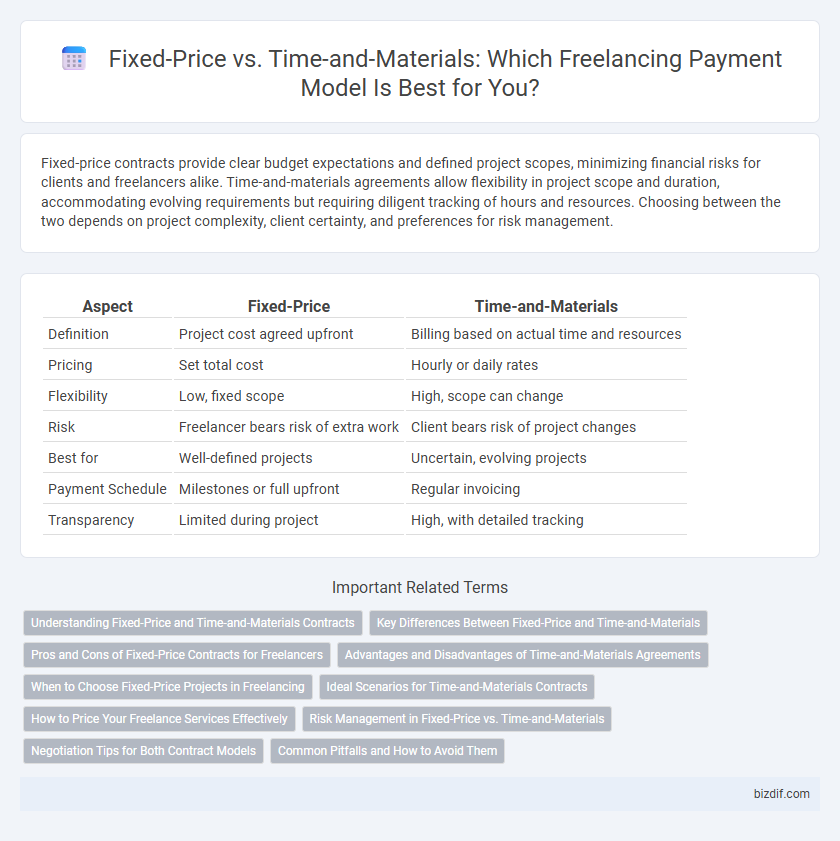Fixed-price contracts provide clear budget expectations and defined project scopes, minimizing financial risks for clients and freelancers alike. Time-and-materials agreements allow flexibility in project scope and duration, accommodating evolving requirements but requiring diligent tracking of hours and resources. Choosing between the two depends on project complexity, client certainty, and preferences for risk management.
Table of Comparison
| Aspect | Fixed-Price | Time-and-Materials |
|---|---|---|
| Definition | Project cost agreed upfront | Billing based on actual time and resources |
| Pricing | Set total cost | Hourly or daily rates |
| Flexibility | Low, fixed scope | High, scope can change |
| Risk | Freelancer bears risk of extra work | Client bears risk of project changes |
| Best for | Well-defined projects | Uncertain, evolving projects |
| Payment Schedule | Milestones or full upfront | Regular invoicing |
| Transparency | Limited during project | High, with detailed tracking |
Understanding Fixed-Price and Time-and-Materials Contracts
Fixed-price contracts define a set budget for a project, providing clear cost predictability and defined deliverables, making them ideal for well-scoped tasks with minimal scope changes. Time-and-materials contracts bill clients based on actual hours worked and resources used, offering flexibility to accommodate evolving project requirements and unforeseen challenges. Understanding the distinctions between these models helps freelancers and clients choose the appropriate agreement based on project complexity, risk tolerance, and payment preferences.
Key Differences Between Fixed-Price and Time-and-Materials
Fixed-price contracts establish a set budget and deadline, providing clear cost predictability and scope definition for both clients and freelancers. Time-and-materials models charge based on actual hours worked and resources used, offering flexibility to accommodate project changes but less cost certainty. Understanding these key differences helps freelancers choose the most suitable contract type based on project complexity and client requirements.
Pros and Cons of Fixed-Price Contracts for Freelancers
Fixed-price contracts offer freelancers predictable income and clear project scope, reducing the risk of scope creep and ensuring timely payment. However, they can limit flexibility, making it challenging to accommodate changes or additional client requests without renegotiating terms. Freelancers risk underestimating project effort, which may lead to lower profitability compared to time-and-materials contracts.
Advantages and Disadvantages of Time-and-Materials Agreements
Time-and-materials agreements offer flexibility by allowing project scope, resources, and timelines to adjust as needed, making them ideal for complex or evolving freelance projects. They provide transparency in billing by charging based on actual hours worked and materials used, minimizing the risk of underestimating project requirements. However, these contracts can lead to higher costs if projects are not closely managed, and clients may face unpredictability in final expenses compared to fixed-price agreements.
When to Choose Fixed-Price Projects in Freelancing
Fixed-price projects are ideal for freelancing jobs with clearly defined scopes, well-established requirements, and predictable timelines. Choosing fixed-price contracts minimizes risks related to budget overruns and scope creep, providing financial certainty for both freelancers and clients. This pricing model suits tasks like website design, content creation, or graphic design where deliverables and deadlines are explicit.
Ideal Scenarios for Time-and-Materials Contracts
Time-and-materials contracts are ideal for projects with evolving requirements and uncertain scopes, allowing freelancers to adapt and charge based on actual work hours and resources used. They suit complex software development, research, or consulting tasks where flexibility and continuous feedback are crucial. This model ensures transparency and fair compensation while accommodating changes without renegotiating the entire contract.
How to Price Your Freelance Services Effectively
To price freelance services effectively, choose between fixed-price and time-and-materials models based on project scope and client preferences; fixed-price suits well-defined projects with clear deliverables, while time-and-materials offers flexibility for ongoing or uncertain tasks. Accurately estimate labor hours, software costs, and overhead expenses to ensure profitability without sacrificing competitiveness. Incorporate market research on industry rates and adjust pricing strategies to reflect skill level, experience, and value delivered.
Risk Management in Fixed-Price vs. Time-and-Materials
Fixed-price contracts transfer the risk of scope changes and time overruns to the freelancer, requiring precise project definitions to avoid potential losses. Time-and-materials agreements place the risk on the client by tying payment directly to hours worked and resources consumed, ensuring flexibility but potentially leading to higher costs. Effective risk management in freelancing involves selecting the contract type that aligns with project uncertainty, budget constraints, and client trust levels.
Negotiation Tips for Both Contract Models
When negotiating fixed-price contracts, clearly define the project scope, milestones, and deliverables to avoid scope creep and ensure mutual agreement on expectations. For time-and-materials contracts, establish transparent hourly rates, tracking methods, and communication protocols to maintain trust and accurately monitor billable hours. Both models benefit from setting a detailed contract, regular progress updates, and open discussions to address any changes or concerns promptly.
Common Pitfalls and How to Avoid Them
Fixed-price contracts often lead to scope creep and budget overruns if the project requirements are not clearly defined from the start, making thorough project scoping essential to avoid disputes. Time-and-materials contracts can result in inflated costs without proper tracking and regular communication between freelancers and clients, so implementing transparent time-logging tools and setting periodic check-ins is crucial. Both models require clear agreements and proactive management to balance flexibility, control, and predictability in freelancing projects.
Fixed-Price vs Time-and-Materials Infographic

 bizdif.com
bizdif.com